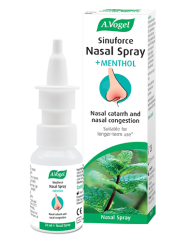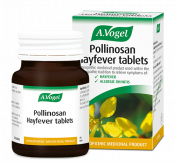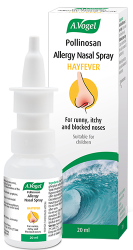How do you treat allergies naturally?
Do you ever feel as though your allergies, whether they are caused by pollen, dander, or something else, leave your concentration waning? Well, fear not, you are not alone!
Allergic rhinitis has been proven to reduce decision-making ability, learning speed and psychomotor speed (our ability to detect and respond to stimulus in the environment around us).1 This, in turn, can result in reduced productivity and attendance at work.
These issues may be linked to allergy symptoms themselves – who can really concentrate when they are having to blow their nose every few minutes? It can also be a side effect of medications, as the most heavily prescribed treatment for allergies, antihistamines, can sometimes cause drowsiness.
We can avoid these sorts of side effects by using natural allergy treatments and, as a result, they are a hugely popular option for those with allergies. In the rest of this blog, I will discuss some of my favourite options provided by nature!
- Luffa
- Nettle
- Neem
- Echinacea
- Chamomile
- Peppermint.
1. Luffa
What is it? Luffa is grown in tropical areas and is part of the cucumber family. In its youth, luffa is a source of edible fruits then, as it matures, it develops a fibrous material that is extracted and dried to make a natural sponge like the one in the image below. Extracts of the fruit are also used in some natural hayfever remedies, making this one very versatile plant!
How can it help? Luffa is a traditional remedy that can be helpful when suffering from frustrating symptoms such as sneezing, blocked nose, runny nose and itchy eyes that are caused by hayfever and other airborne irritants like dust or animal dander.
Where can I find it? There are a dozen varieties of luffa but here at A.Vogel we use a type called Luffa operculata in our products. This is can be found in our Pollinosan Hayfever tablets, as well as the Pollinosan Nasal Spray, so you've got lots of options!

2. Nettle
What is it? Nettle, or to give its official name, Urtica dioica, can be found all over the world. It is characterised by flat, heart shaped-leaves and its ability to induce a painful sting!
How can it help? It may seem contradictory to use a weed like nettle to treat an allergy like hayfever, but science backs this method up!
Nettle is known to work a little like an antihistamine, modulating the body's immune response. Rather than over-reacting to the presence of allergens, the immune system becomes more inclined to ignore them. Nettle also inhibits some of the inflammatory processes that lead to allergic rhinitis and hayfever symptoms such as congestion and itchy skin.
And it seems I am not the only person raving about nettle! In a study involving 69 people with allergic rhinitis symptoms, 58% found that nettle helped their symptoms and 48% said it was equally or more effective than their previous treatment.2
If you fancy learning about how nettle works in a little more detail, check out my blog 'How can nettle help your allergies?'!
Where can I find it? Nettle tea is widely available in health food stores and supermarkets, or you can check out how to make your own nettle tea in my video below. Another option is our Stinging Nettle Urtica Drops which are made from the aerial parts of the plant.
My Self-Care Tip: How to make your own nettle tea
A popular natural hayfever remedy, nettle can be made into a refreshing tea. Find out how to do it yourself below!
3. Neem
What is it? Neem is a tree you'll be more likely to see growing in tropical regions than the not-so-sunny shores of the UK! Neem trees are large and bushy and are considered 'evergreen', as they remain so year-round. The Neem tree produces seeds, leaves and oil that are used in various products, from creams and body lotions to shampoo.
How can it help? If your allergies contribute to irritated or red skin flare-ups, it is worth trying a Neem-based product, as these can have a calming, soothing effect on troubled skin.
Neem has anti-inflammatory properties3, providing some explanation as to why it has a beneficial effect on allergy sufferers.
Where can I find it? Health food stores and online retailers provide a range of Neem products. We also have our Neem Cream which is made from the tincture of Neem leaf.

4. Echinacea
What is it? This colourful flower is part of the daisy family and is native to North America, though it is also grown across Europe, including in our fields in Switzerland! There are ten species of Echinacea and they are prized for their attractive appearance and their medicinal properties.
How can it help? Echinacea purpurea helps to support the immune system and we need a strong and healthy immune system in order to deal with allergens.
Where can you find it? You will find extracts of Echinacea in most health stores and some pharmacies. Look out for products that use fresh, organically grown extracts of Echinacea herb and root, however, as these contain more of the plant's beneficial properties than dried versions. Being caffeine-free and refreshing in taste, Echinacea is also a popular tea.

5. Chamomile
What is it? This pretty daisy-like flower is grown extensively in Europe, the United States, India and Asia. It has lots of promising health benefits and is used in a range of products, from shampoo to skin creams.
How can it help? Chamomile can help allergy sufferers in a few ways, depending on what your symptoms are. If you are prone to dry eyes, for example, it can help to place a few cooled tea bags onto your eyelids for a couple of minutes – perhaps in the ad break whilst watching tv!
As well as this, chamomile may help with inflammation, so that's quite useful if you are prone to inflammatory symptoms like congestion. There's also the added benefit that chamomile tea is comforting and relaxing so, if your allergy symptoms are making it hard to sleep, you may find it soothing to have a mug before bed.
Where can you find it? Dried chamomile flowers are widely used to flavour teas which can be purchased in most supermarkets. Chamomile is also available as an essential oil to be used in a diffuser.
Here at A.Vogel, we add chamomilla recutita extract to our Sinuforce Nasal Spray for its soothing properties. This is a useful product if your sensitivities leave you prone to congestion or catarrh. This nasal spray can also be used for up to 30 days, which is particularly helpful when experiencing recurrent bouts of allergic rhinitis.
My Top Tip:

Use the Sinuforce Nasal Spray to help a blocked or congested nose.
Spray twice in each nostril 3-5 times daily.
"Because it clears uncomfortable nasal congestion which allows for better sleep. A good size to carry around too."

6. Peppermint
What is it? Peppermint is grown and harvested across the world to be used in several products, from food to toothpaste. Peppermint is easy to grow at home too, though you may want to keep it in a pot to prevent it from taking over!
How can it help? Peppermint is anti-inflammatory in nature, meaning it's another herb that may soothe symptoms caused by the body's extreme reaction to allergens.4 It also offers a refreshing scent that may go some way to clearing the sinuses.
Where can you find it? Again, peppermint teas are widely available from supermarkets and health food stores. You could also make your own by placing a handful of loosely chopped leaves into a cup of tea and then leaving them to brew for a few minutes.
Peppermint oil can is also a popular product. If suffering from a runny or blocked nose, you may find it refreshing to apply a few drops of this to your tissue.

References
1 https://pubmed.ncbi.nlm.nih.gov/8372999/
2 https://pubmed.ncbi.nlm.nih.gov/8372999/









